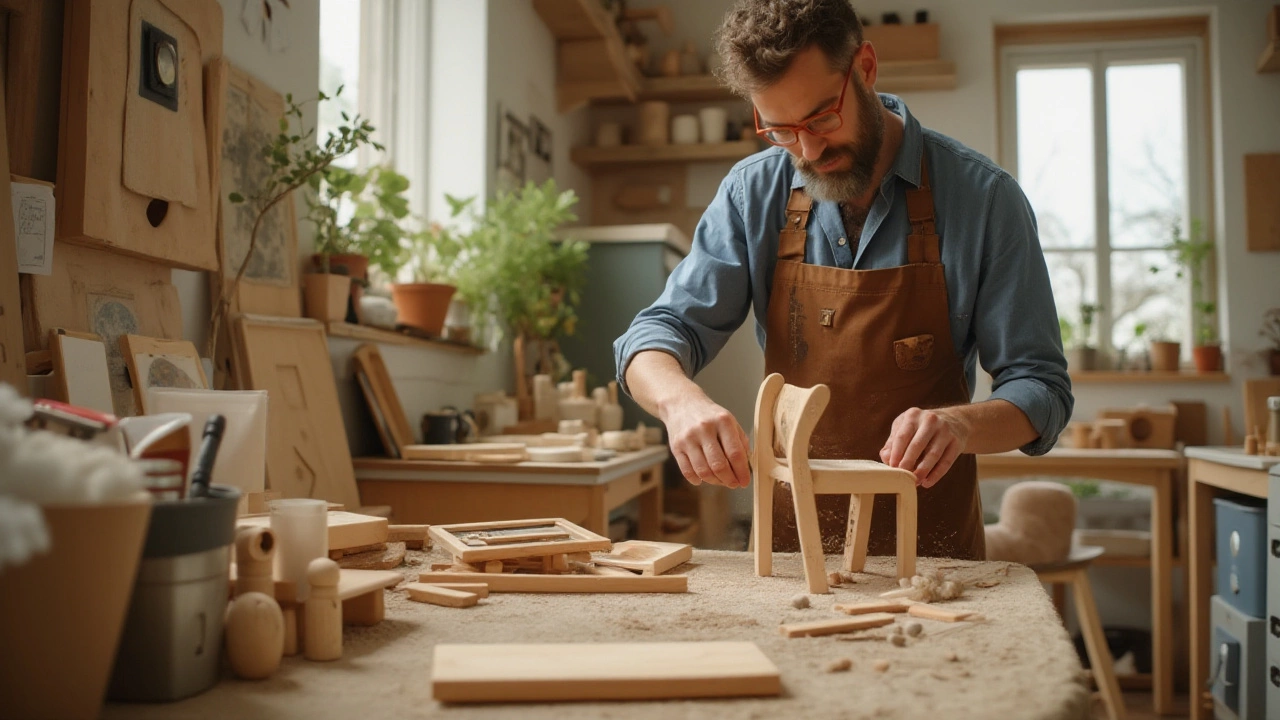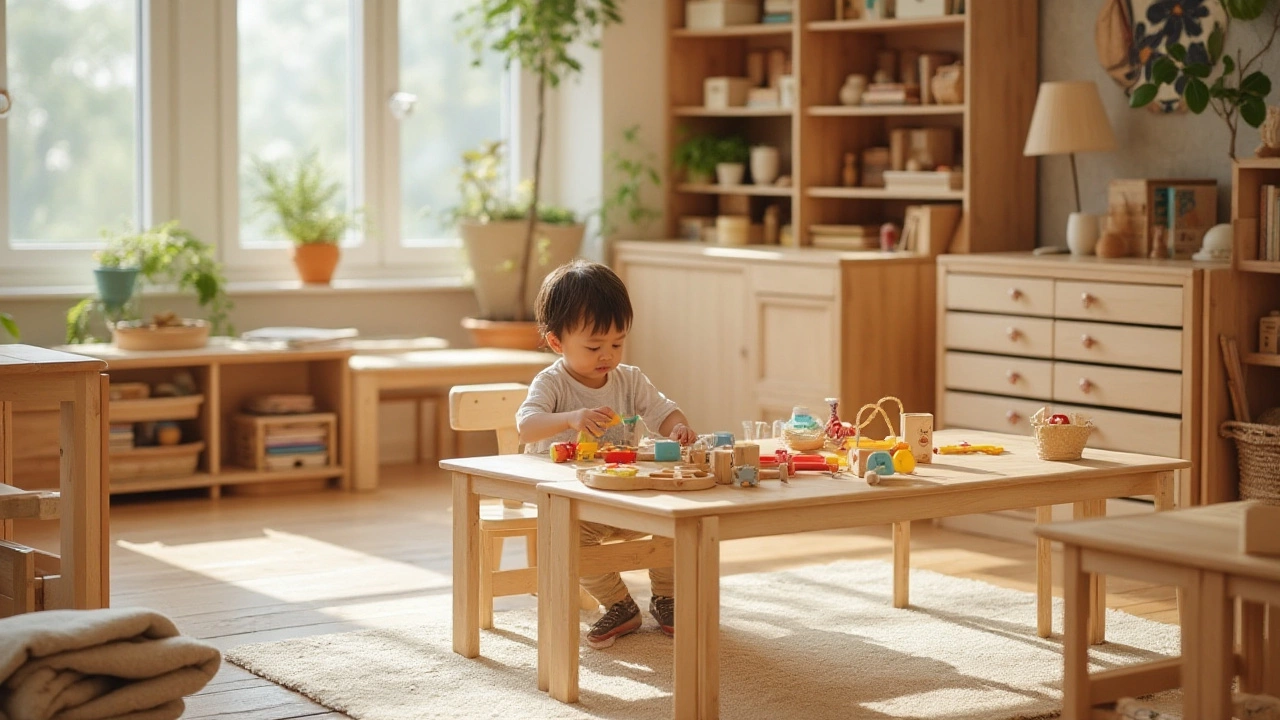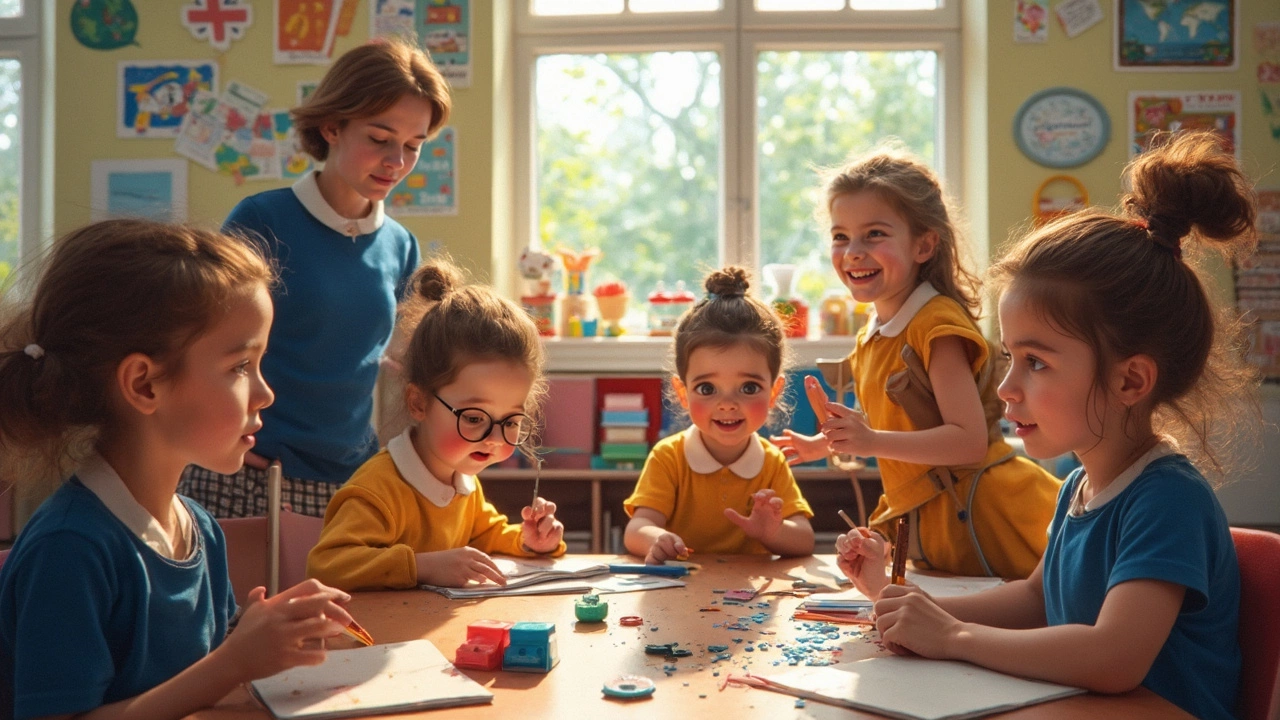Uncovering the Cost Behind Montessori Nursery Furniture

If you've ever wandered into the world of child-friendly home design, you've likely stumbled upon Montessori furniture. With its clean lines and minimalist elegance, it's not just another trend. Yet, one might wonder why this particular style comes with a hefty price tag.
Montessori furniture isn't merely about aesthetics; it's an investment in your child's development. The journey begins with understanding the philosophy that emphasizes independence, self-directed learning, and freedom within limits. These principles are woven into each piece's design and functionality, setting them apart from conventional nursery furniture.
Join me as we pull back the curtain on what makes these innovative pieces so sought after—and why they could be a crucial addition to your child’s environment.
- Understanding the Montessori Philosophy
- Craftsmanship and Quality Materials
- Design and Functionality
- Benefits of Montessori Furniture
- Tips for Budget-Friendly Alternatives
Understanding the Montessori Philosophy
The Montessori Philosophy is a celebration of discovery, learning, and growth that aligns closely with a child's natural development. It challenges the traditional approaches to education, advocating for a model where children learn through interaction with their environment. This approach finds its roots in the pioneering work of Dr. Maria Montessori, an Italian physician and educator, who in the early 20th century revolutionized how we perceive childhood learning. Her philosophy is grounded on the idea that children are naturally curious individuals who thrive when given the freedom to explore materials that meet their developmental needs.
The hallmark of the Montessori Method is its emphasis on hand-on learning and collaborative play. Montessori classrooms, or 'prepared environments' as they are called, are designed to allow children to choose their activities freely. This method encourages kids to take charge of their learning journey, thereby fostering independence and self-discipline—qualities that Montessori furniture seeks to enhance. The furniture is crafted keeping this philosophy in mind. Tables and chairs are made low to the ground so children can sit and move with ease, giving them a physical autonomy that is rare in traditional designs.
Montessori education also places high importance on sensory development. The nursery furniture, therefore, is made from natural materials such as wood, which offers a tactile experience unlike synthetic materials. The natural world is a significant focus; Montessori believed that learning is best when it is intertwined with nature, which is why you'll frequently find elements resembling the natural environment within the designs. The careful attention to these materials ensures that furniture not only withstands the test of time but also aids touch, sight, and thought, sparking a child's curiosity.
The Role of Environment
Montessori environments stand out because they are tailored to the child's size and capabilities. This is where furniture plays a crucial role. Every piece of furniture is intentionally crafted to cater to a child’s need for independence and movement. You’ll notice that Montessori nurseries feature open shelving, which allows children to access toys and materials without assistance. This aspect, while seemingly simple, is revolutionary as it shifts the balance of control towards the child, permitting them to make choices independently. This crafted independence encourages intrinsic motivation and enhances decision-making skills early on.
The American Montessori Association underscores the importance of this approach, stating, "When children can make choices, they develop confidence and a sense of ownership over their learning."
The Montessori method doesn't just affect the way furniture is designed, it transforms the entire living space into a nurturing realm of exploration and learning. Every piece is a testament to a child's growing independence and resilience. In the long term, adhering to these philosophies can equip your child with critical life skills that transcend academic prowess, cultivating emotional intelligence and a lifelong love for learning.
Craftsmanship and Quality Materials
When delving into the allure of Montessori furniture, the significance of craftsmanship and quality materials can hardly be understated. Every piece of Montessori furniture is crafted with a precision that mirrors the meticulous nature of child development itself. The artisans behind these creations often dedicate years to mastering their craft, ensuring that the furniture is not only beautiful but also functional and safe for small hands. Each curve and joint is carefully considered, a testament to the artistry that lies in simplicity.
Interestingly, many pieces are constructed using solid woods like maple, beech, or oak. These materials are chosen not only for their durability and strength but also for their non-toxic properties, essential for safe home education. Unlike mass-produced items, Montessori furniture emphasizes natural finishes. The use of water-based stains and sealants helps preserve the wood's innate beauty while keeping potential toxins at bay, safeguarding young explorers as they navigate their surroundings.
The dedication to quality extends beyond materials to include construction techniques. Mortise and tenon joinery, a time-tested woodworking method, is commonly employed to ensure stability and longevity. This method allows pieces to withstand the inevitable wear and tear of childhood use. The longevity of these furniture pieces is what makes them prized investments for parents committed to creating sustainable, eco-friendly homes. By selecting items that pass the test of time, families can maintain a environment devoid of hurried replacements and waste.
According to the American Montessori Society, "The materials used in Montessori environments must be beautiful, durable, and accessible; only in this way can children truly engage fully in their learning."
Montessori furniture also prioritizes ergonomics. From tables and chairs to shelving units, each item is designed with the child's perspective in mind. This commitment to design ensures that children remain comfortable and confident in their independence. By doing so, it facilitates a learning experience that feels natural and unobtrusive, allowing small bodies to move effortlessly and intuitively as they learn and explore.
For many parents, the cost of Montessori furniture lies not in the prestige of owning a piece, but in the assurance that their investment actively contributes to their child's growth and development. By prioritizing craftsmanship and quality materials, these pieces hold not only their physical form but also the philosophy of child-centered learning within every inch. Investing in well-made, thoughtfully designed furniture creates an environment where children can thrive, making the initial expenditure a wise choice for those prioritizing their child's future and wellbeing.

Design and Functionality
Walking into a room furnished with Montessori furniture, you'll encounter a distinctive aura of simplicity paired with functionality. At the heart of its design lies an intention that transcends mere aesthetics. Every piece is crafted to meet the evolving needs of children, encouraging independence and early learning. It's not just about what you see; it's about the child's journey of discovery that these designs facilitate. Imagine a toddler-sized table, perfectly matched with chairs for those tiny hands and feet, promoting autonomy as they explore activities at their own pace.
An ingenious aspect of Montessori design is its deliberate choice of size and scale. When everything is accessible, children are empowered. Instead of waiting for an adult, they can independently choose resources and activities, sharpening decision-making skills. This philosophy stems from Dr. Maria Montessori's belief that children thrive when they manage their environment. Montessori furniture is foundational to building such environments, driving the essence of independence.
This furniture often incorporates open shelving to showcase a carefully selected array of learning materials. Unlike traditional toy boxes, which can overwhelm with clutter, open shelves invite tidiness and organization. As children interact daily with these pieces, they learn essential life skills like order and responsibility. A Montessori room almost always features platforms instead of traditional beds, fostering freedom of movement and providing a safe, accessible space for rest.
A famed principle in Montessori design is the integration of natural materials. Wooden elements, often responsibly sourced, are preferred for their tactile quality and durability. The grain of wood, its weight, and even the smell become part of the child's sensory education. It's common to hear experts like Tim Seldin, from the Montessori Foundation, emphasize,
"The environment must be rich in motives which lend interest to activity and invite the child to conduct his own experiences."
In terms of color palette, Montessori furniture often sticks with neutral and pastel shades. The subtle tones avoid distraction, so the focus is on learning, not overstimulation. Clever design also ensures adaptability; many pieces are modular or able to evolve alongside a growing child. A simple shelf can turn into a desk with minimal adjustments, ensuring longevity and extending the furniture's lifespan.
Let's talk about some clever innovations in design. Many Montessori furnishings include elements of learning within their structure. Puzzle-piece chairs or tables with embedded counting beads can seamlessly turn a living area into a learning landscape. This brilliance in design ensures that a space influences growth and exploration as much as possible. Ultimately, the design and functionality effectively offer a seamless blend of beauty and purposeful use, making Montessori furniture a cherished choice for parents intent on nurturing their child's environment in education-focused homes.
Benefits of Montessori Furniture
When it comes to designing a child's space, choosing quality nursery furniture could make all the difference in their growth journey. Montessori furniture stands out not just because of its unique aesthetic, but due to its deep-rooted purpose in fostering independence and self-reliance. Crafted meticulously to ensure children can access and use it independently, this furniture often becomes a child's gateway to acquiring new skills and exploring their environment more confidently. A well-designed piece, such as a low shelf or a child-sized table, allows children to take responsibility for their learning, ushering them into a space where curiosity leads the way.
What sets Montessori furniture apart is its focus on simplicity and functionality that aligns with a child's developmental needs. A cleverly placed step stool gives a toddler the means to reach for their own book, while an open wardrobe at their height empowers them to choose their clothing. This empowerment is not just about physical access but also about making informed decisions, which aids cognitive development. Numerous studies have revealed that environments designed with these principles can enhance concentration, foster independence, and even boost creativity. Maria Montessori herself emphasized the importance of the environment in childhood education, seeing it as a vital component in the learning process.
"Environment is a main factor in a child's education." - Maria MontessoriAnother significant benefit of Montessori nursery furniture is its durability and attention to environmentally conscious materials. These pieces are often made from robust, sustainable materials that ensure longevity. While some parents might shy away because of the upfront cost, the investment pays off in terms of enduring quality and timeless design that can be passed down through generations. Notably, many companies crafting these pieces prioritize eco-friendly production processes, contributing not just to a greener planet, but to safer homes for children.
Moreover, having Montessori furniture in the home often brings about a shift in parenting philosophy. Parents begin to notice how these pieces promote not just a different learning style, but a lifestyle change that encourages children to take an active role in their development. This hands-on learning paradigm is not only applicable within the home but extends to a child's interaction with the world. As they see their own little tasks mapped out in an apartment designed for exploration and participation, children are likely to carry these skills into their schooling and beyond.
For those considering Montessori furniture, understanding its comprehensive benefits can make the decision easier. From supporting independence and offering reliable durability, to nurturing a child's keen sense for learning, these furniture pieces are more than just objects in a room. They are instruments of childhood development that respect and celebrate a child's individual learning journey, fostering a sense of accomplishment and joy in discovery. While strikingly different from traditional nursery decor, the Montessori approach tends to align closely with many modern parenting values, prioritizing the child's holistic growth above all else.

Tips for Budget-Friendly Alternatives
Creating a nurturing environment that embodies the Montessori philosophy need not cause financial strain. For many parents, the key lies in being resourceful and mindful in choosing or making Montessori furniture. To emulate the warm, inviting ambiance of a Montessori setting without overspending, begin by focusing on the essentials. Multitasking furniture, like a low shelf that doubles as a play surface or storage unit, offers both practicality and spatial efficiency. The DIY route also beckons with its creative charm. Many parents have turned to refurbishing old furniture pieces; sanding them down to child-friendly heights and painting them with eco-friendly finishes to mirror the simplicity of Montessori design.
Another clever approach involves sourcing pre-loved items from thrift stores or online marketplaces. Websites dedicated to handmade goods often feature innovative pieces that capture the essence of Montessori design at a fraction of the cost. Be open to variations from the classic look; sometimes even a non-Montessori piece can serve the purpose if it fosters independence and accessibility. If you're comfortable wielding a few tools, crafting your own furniture is an option. Many online tutorials and forums provide step-by-step guides to building popular Montessori items like learning towers and low beds. This not only saves money but also allows a personal touch to grace your child’s nursery.
“When you make your home an environment where your child can thrive independently, you’re applying the Montessori principles in the most personal and meaningful way,” suggests Claire Watson, director of educational development at The Montessori Network.
Consider collaborating with other parents in your community to exchange materials or share ideas. Sometimes, having a mini co-op can lead to bulk purchasing discounts and diverse, low-cost furnishing solutions. It's all about being resourceful and creative. Finally, remember that the heart of Montessori is not in the furniture, but in the freedom and learning it supports. With these strategies, you can maintain the spirit of Montessori learning on a budget that suits your unique situation.

